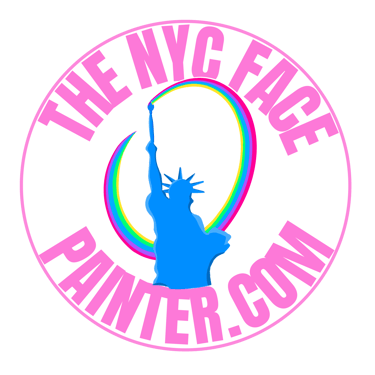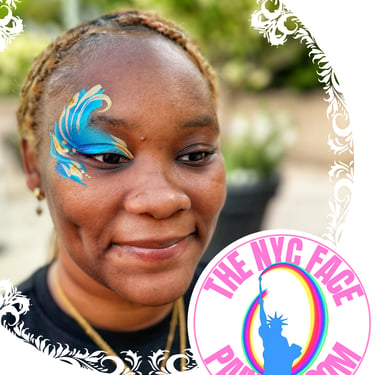
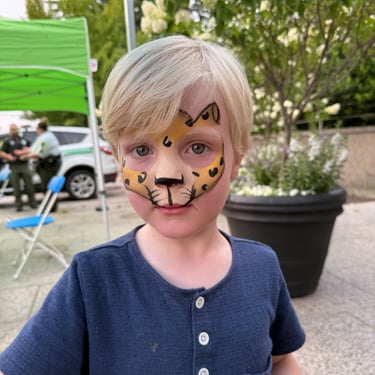
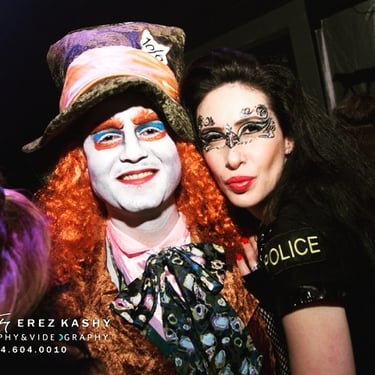
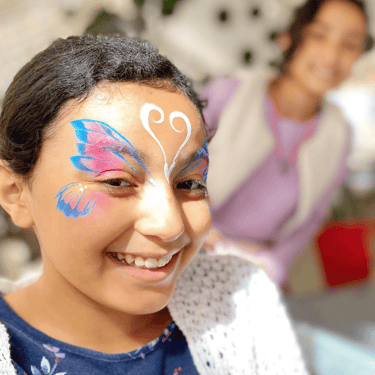
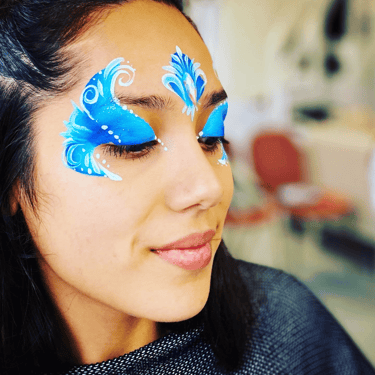
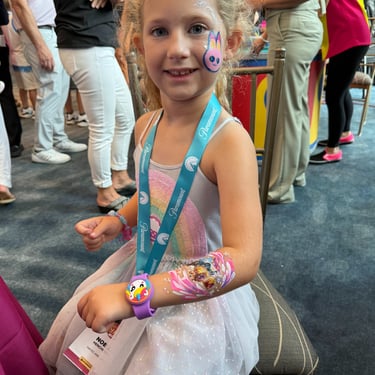
Q1. What types of face paint are safe for skin?
Only use professional, cosmetic-grade face paints made for skin. Avoid craft paints, acrylics, or markers, which can cause irritation. Look for FDA-compliant, hypoallergenic brands.
Q2. How do I remove face paint?
Most professional face paints wash off with soap and water. Use a gentle baby wipe, makeup remover, or mild cleanser for stubborn colors. Always remove before sleeping.
Q3. Can face paint cause allergic reactions?
It’s rare, but possible. People with very sensitive skin should request a patch test on the inner arm before a full design. Choose hypoallergenic paints when available.
Q4. What’s the difference between airbrush and traditional face painting?
Airbrush: Sprayed on using stencils, smooth finish, faster for large crowds, lasts longer.
Brush & sponge: Hand-painted, more detailed, artistic and layered designs, washes off more easily.
Q5. How long does it take to paint one face?
Quick, simple designs: 3–5 minutes.
Full-face designs: 10–15 minutes.
At parties, expect 10–12 children per hour depending on design detail.
Q4: Is face paint water-based?
Yes, professional face paints are typically water-based. This means they are activated with a small amount of water, apply smoothly with brushes or sponges, and dry quickly without feeling heavy. Water-based paints are also safer for the skin, easy to layer for vibrant designs, and simple to remove with soap and water. Unlike oil-based products, they won’t clog pores or leave a greasy residue.
Q7. How is hiring a face painter charged?
Most face painters charge by the hour, with rates depending on the artist’s experience, event size, and location. Some offer packages (for a set number of hours or a flat rate for parties), while larger events may be priced per face or per design. Additional costs can apply for travel, specialty designs, glitter tattoos, balloons or add-on services. On average, you can expect professional face painting services to range from $200–$300 per hour in most cities.
Q8. How many hours do I need to book for face painting?
It depends.
For 10-12 kids, one hour.
For 12-15 kids 1.5 hours
For 15-20 kids 2 hours
20+ 3 Hours and/or more than one painter
Q9. Do I need to do a patch test before applying face paint?
It’s optional, but recommended for very young children or people with sensitive skin. Apply a little on the inner arm and wait 20 minutes.
Q10. Can face paint stain skin, clothes, or bedding?
Some darker pigments may temporarily tint skin. Stains on fabric are more permanent. Use a bib or towel for young kids and remove paint before bed.
Q11. Are there age limits for face painting?
Under 2 years old: not recommended, as skin is delicate and kids often rub their eyes.
Otherwise: safe for children, teens, and adults of all ages.
Q12. What supplies do you need for face painting at events?
A standard kit includes: professional paints, brushes, sponges, water cups, glitter, stencils, wipes, hand sanitizer, table/chair setup, and hygiene supplies.
Q13. How do you keep your tools clean?
Brushes and sponges are washed with antibacterial soap between uses. Water is changed regularly. Only cosmetic-grade glitter is used. Artists follow hygiene standards.
Q14. Can I sleep with face paint on?
No. Always remove face paint before sleeping to avoid irritation and stained sheets
Halloween & Day of the Dead Face Painting FAQ
Q1. What are Sugar Skulls?
Sugar skulls (or calaveras de azúcar) are colorful, decorative skulls traditionally used during Mexico’s Día de los Muertos (Day of the Dead) celebrations. They are often made from sugar or clay and decorated with bright designs, flowers, and patterns. Symbolically, sugar skulls represent the beauty and sweetness of life while honoring loved ones who have passed away. In face painting, sugar skull designs recreate this tradition with vibrant colors, floral details, and festive embellishments.
Q2. What’s the Difference Between Glam Skulls and Sugar Skulls?
A Sugar Skull is rooted in Mexican Día de los Muertos tradition — colorful, symbolic, and decorated with flowers, swirls, and bright details to honor loved ones. A Glam Skull, on the other hand, is a modern, fashion-inspired twist on the classic skull look. It focuses on metallics, glitter, jewels, and dramatic makeup effects, leaning more toward beauty and high-style Halloween artistry than cultural symbolism.
Q3. What’s the difference between Halloween skull makeup and Day of the Dead (Día de los Muertos) sugar skulls?
Halloween skulls: Dark, spooky, hollow-eyed, usually black and white.
Day of the Dead sugar skulls: Colorful, floral, often with gems or glitter, meant to honor and celebrate loved ones.
Q4. Can kids get sugar skull designs too?
Yes. Designs can be softened with bright flowers, hearts, or butterflies to make them fun and child-friendly.
Q5. How long do sugar skull designs take?
A simple half-face: 10–15 minutes.
A full, detailed sugar skull with flowers and gems: 20–30 minutes maybe more
Q6. Do you provide glitter or gems for Day of the Dead looks?
Yes, cosmetic-grade glitter and stick-on gems can be added to enhance the festive, colorful look.
Q7. Will my Halloween or Day of the Dead face paint last all night?
Yes, professional paints are long-lasting if not rubbed excessively. For outdoor festivals, setting spray or powder helps extend wear.
Q8. Can I get half-face designs for Halloween?
Yes. Half-face skulls, masks, or “split-face” designs (half human, half zombie) are very popular for quicker painting.
Q9. Are Day of the Dead designs respectful to wear?
Yes, when done tastefully to honor the tradition. They celebrate life and loved ones who have passed, not just “spooky looks.”
Q10. How should I remove heavy Halloween makeup or sugar skull paint?
Soap and water. Or use a gentle cleanser or baby oil on cotton pads to loosen pigments, followed by soap and water. Always moisturize afterward.
